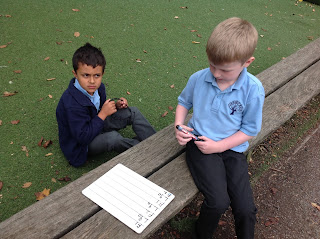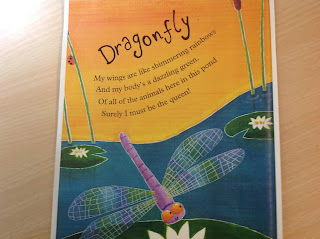This week
in English we have been continuing learning about poetry.
On
Monday we were given the sentence
Long, wriggly worms
wriggling in the soil.
We had
to identify the adjectives and the
nouns.
We then
used the pattern of adjective, comma, adjective noun (an expanded noun phrase) to write our own sentences in pairs. We then had to think of a verb to describe what it was doing.
By
the end of the lesson we had made our own class four sentence poem about
minibeasts.
On
Tuesday we used the same pattern to write our own minibeast poems. We use the toolkit to remind ourselves of
what we needed to include.
On
Thursday we edited our poems with our teachers to make them even better
before writing them in our best handwriting ready to display.
At home you may like to play a game
of identifying the adjective (describing word), the noun (naming word) and
verb (doing or action word) in a sentence. Your child could then write their
own expanded noun phrase ( adjective comma adjective noun) to bring into
school. You may also like to be
expanded noun detectives when reading stories.
In
phonics we have been recapping the digraphs ee, ea and the split digraph e-e.
Make a list of words with these
digraphs and then write a sentence using them.
In
handwriting we have been learning the letters u e w and the
words
we,
wet, wilt and lute.
Encourage your child to practise these
at home. You will find the letters and
words on letterjoins under easy letters and easy words. We would love to see
the children’s work.
We have
recently done a spelling assessment with the chidren of all the Year 1 common
exception words. The following words ome children found tricky – says, said,
were, there, where, come, some, friend, school and house.
Please keep practising the Year 1
common exception words at home to ensure they are embedded before we start
teaching the year 2 words.
A good strategy is ‘Look, cover,
write, check’
On Monday in maths using number lines we had to fill in the missing numbers. Next we put numbers on a blank number line and some of us challenged ourselves to put the same number eg 45 on number lines of different scales. 0__________________________50 0__________________________100 0__________________________ 60 During the rest of the week we revisited our learning on partitioning numbers into tens and ones. We used arrow cards to show how to partition and then recombine. 42 when partitioned is made up of 40 + 2 When recombined the number goes back to 42. Follow the link to play the arrow cards game (make 2 digit numbers only) ictgames.com/mobilePage/arrowCards/index.html We then tried to partition the number 42 using other representations . We could use the tens frame, Numicon, the part,part, whole model or diennes. We then thought of other ways of partitioning 42 30+12 = 42 20 + 22 = 42 What other ways can you find? Can your child partion the number 42 in three ways? 20+ 20+2=42 Can they find other ways? At home your child could partition other numbers. |
On Friday we used our learning about place value to solve a problem. We started with 4 beads and could place them in the tens or ones column. We tried to find all the possibilities. We then challenged ourselves to use 7 beads and made all the possible numbers and identify the patterns. Please try this at home with your child - maybe use 8 or 9 beads? We tried to work out the pattern of how many different numbers we could make with different numbers of beads. We also thought about what the digits in all the numbers add up to and why? Please ask your child if they can see and explain these patterns.
In art we learnt to hatch and cross hatch using different thicknesses of pencil lines to add texture and tone. First we explored and then we applied our skills to carefully draw a selection of mini beasts.
In computing as part of our learning to prepare the children to use Turtle Logo we learnt how to give instructions using the words half a turn and quarter of a turn. We learnt that a quarter turn can be called a 90 turn!
Hope you all have a lovely weekend.
We look forward to celebrating 'Book Week' next week. Don't forget our competition to design a book mark. The lucky winner will receive a £5 voucher to use at the book fair which is in school next week. Also could everyone please bring in a toilet roll tube as we will be making our own mini beasts next week.
Thank you.
The Year 2 teachers
|



















































